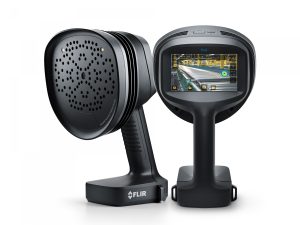GDevCON, a high-level technical event for LabVIEW architects, is not your typical conference. Held over two days in the iconic Glasgow Science Centre, it offers a unique space for collaboration and idea-sharing, free from corporate oversight or control. Here, Chris Knight, technical support engineer at automation and control technology specialist, Beckhoff UK, a gold sponsor at the event, explains the key take aways and the vital function that Inputs and Outputs (I/O) communication plays in connecting systems, exchanging data and ensuring efficient automation.
Unlike trade shows, GDevCON is all about bringing LabVIEW experts together to exchange knowledge and foster a developer community. But what truly sets the event apart is the emphasis on credibility, as exhibitors must know at least one attendee, who either develops or works in LabVIEW, to join.
With that in mind, it was impressive to see GDevCON 2023 welcome approximately 200 attendees, including representatives from organisations like SpaceX, CERN, nuclear research facilities and large National Instruments (NI) systems integrators. It also attracted participants from 23 countries, including the USA and India, along with the presence of five NI employees.
From the numerous talks and conversations that took place, we quickly realised that many of the manufacturers had gaps or deficiencies in their existing production lines.
More specifically, these companies claimed to be absent from — and in need of — cost-effective options for motion control, fieldbus communications and a more extensive I/O range.
Motion control
Motion control, also known as servo control or robotics, is a branch of automation that focuses on precisely controlling the movement of various components inside a machine. The movement of these different parts are usually controlled by rotary and linear actuators.
Machine position and velocity can be regulated using a motion control device, like an electric motor, hydraulic pump, or servo actuator. Typically, industrial operations use motion control to move specified loads carefully, hence controlling the movement of objects falls under motion control.
A challenge in motion control for manufacturers is the delicate balance between precision and efficiency. Achieving highly precise movements in industrial processes is vital for quality and consistency, yet this level of precision often comes at the cost of increased energy consumption and slower production speeds.
Highly precise movements demand meticulous control, which may require more time and energy. However, striking the right balance is essential as motion control systems enhance efficiency, quality and competitiveness in a variety of industries, from manufacturing and robotics to aerospace and healthcare.
Fieldbus communications
Efficiency and movement precision are critical in manufacturing lines. However, fieldbus communication is essential to unlock these benefits.
Firstly, fieldbus networks are a means of communicating with input devices and output devices, without having to connect each individual device back to, for example, the PLC or industrial PC.
Before its introduction, computers would connect using direct serial connections whereby only two devices could communicate per connection. Whereas the fieldbus allows hundreds of analogue and digital points to connect simultaneously, which not only reduces the number of cables required but also cuts down cable length too.
In an industrial setting, this ensures the integration of numerous devices, along with standardised communication and compatibility. Be it in a single machine or across a large plant, the fieldbus network is a significant component that lays the foundations for scalability and dependable industrial automation options.
All about the I/O
By serving as the communication backbone, fieldbus allows various I/O devices to share information efficiently. Here, sensors collect data and send it to the fieldbus, while actuators receive commands from the same network.
This integration streamlines control, reduces wiring complexity and centralises monitoring, making it ideal for applications with extensive I/O requirements. However, those without an extensive I/O range can come across problems, especially in terms of scalability.
For instance, a narrow I/O range may create obstacles for manufacturers wanting to meet the diverse needs of their customers, because they lack the necessary sensor and actuator options. This, in turn, restricts market reach due to the limitations in being able to alter production lines for custom products.
This reinforces the critical role I/O plays, as without it, industrial and electronic devices would not receive data. In essence, it forms the bedrock of industrial control and data processing, with I/O modules serving as intermediaries between a central processor and the industrial device to ensure connectivity.
For instance, within a programmable logic controller (PLC), input modules can receive signals from switches, sensors, transmitters, actuators and other connected equipment. While output modules on the PLC transmit response signals to the devices controlled by the PLC in response to the received signals.
EtherCAT is the answer
EtherCAT is a communication protocol often used in industrial automation where quick data exchange between devices is essential, including those within a PLC. Moreover, it is highly scalable and can accommodate a large number of devices on a single network, making it suitable for both small-scale and large-scale industrial applications.
Digital options, such as Beckhoff’s TwinCAT automation software, offers EtherCAT as a primary communication option. This not only enables users to configure, manage and control EtherCAT-based automation systems, but also provides EtherCAT Master functionality too.
For example, PLCs connected via EtherCAT can connect and control various aspects of the assembly process, ensuring synchronised movement of robots, conveyor belts and quality control sensors for precise coordination.
It must also be noted that this prevents companies from having to design raw data to scaled values in-house. Instead, the software has the modules to do that for you — a need that was highlighted at GDevCON and one that helps to plug the gaps in a plant’s production line.
If you’d like to learn more about Beckhoff’s secure communication protocol, TwinCAT and other control technology, visit www.beckhoff.com.

 Instrumentation Monthly Test | Measurement | Control
Instrumentation Monthly Test | Measurement | Control








